Table of Contents for Natrona County, WY Native or Nearly Native Milkweeds
There are fifteen species of native or nearly native Natrona County milkweeds (Asclepias spp.) that can be grown for butterflies and other insects. Milkweeds are an important host species for monarch butterflies in Wyoming. The monarch butterfly in particular uses the cardenolides found in the milky sap of milkweeds to give an unpleasant taste to predators. These plants are also an important nectar source to all insects visiting your pollinator garden.
General Information about Native Plant and Pollinator Gardens
When planting a native plant and pollinator garden in Natrona County, WY, you need to ensure that you have a selection of plants that provide blooms at different times of the year. In addition to the plants, you need to provide a source of water such as a birdbath or water feature, shelter for animals, and nesting locations for birds. Be sure to also include plants of different heights for perching. Resources you can use for more information on butterfly gardening in Natrona County include the Wyoming Native Plant Society, Casper Master Gardeners, or University of Wyoming Extension.
Location of Natrona County, WY

Natrona County is located in central Wyoming. Casper, WY is the largest city in the county.
USDA Plant Hardiness Zones in Natrona County, WY

Natrona, WY has two main plant hardiness zones (5a and 5b) and a very small area of 4b. When selecting plants in the City of Casper you will want to get those that can handle temperatures as cold as -200F. Other parts of Natrona County will range from -150F to -250F depending on your hardiness zone.
Butterflies in Natrona County, WY that are Hosted by Milkweeds (Asclepias spp.)
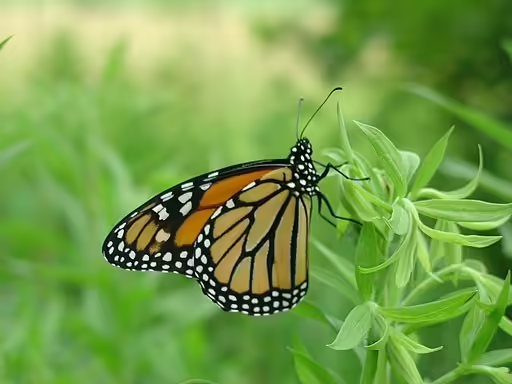
Monarch Butterfly (Danaus plexippus)
The monarch butterfly is an iconic butterfly in North America and is a bell-weather of the environment. Having a distinctive orange color with black stripes, this butterfly has a wingspan of 3 in (7.6 cm) to 5 in (12.7 cm). The monarch butterfly uses milkweed to get cardenolides, a toxin that is distasteful to predators. This butterfly can have several flights a year and is known for its migrations to Mexico each year. However, some populations in California, Arizona, and Florida do not migrate and breed year-round (Urguhart, et al 1968).
List of Milkweeds that are Native or Nearly Native in Natrona County, WY
1. Sand Milkweed (Asclepias arenaria), a Milkweed for Sandy Soils
Sand Milkweed grows best in places of full sun and well-drained sandy soils. It is best to plant this species in the spring after the last frost to aid in establishment before the summer. Once this plant is established it requires little maintenance, but it can be helped by removing other plants that may be crowding it.
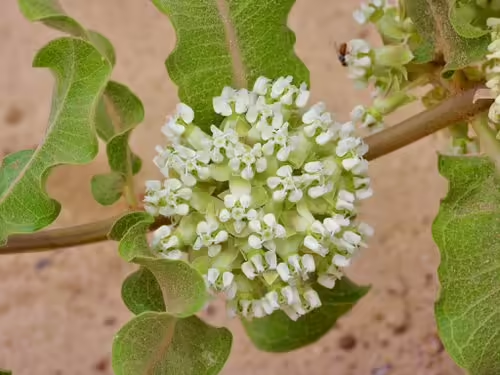
Facts about Sand Milkweed
- Native to Wyoming: Yes, rare in one county in southeast Wyoming (Kartesz 2015)
- Native to Natrona County: No
- Natural Habitat: fields, pastures, dunes, sandhills, and roadsides
- Height: up to 3 ft (0.9 m)
- Flower Color: pale-green to greenish-white with pale purple hoods
- Flowering Period: May to October
- USDA Hardiness Zone: 4-9
Gardening with Sand Milkweed
In your Natrona County, WY butterfly garden, this milkweed needs full sun and sandy well-drained soil.
2. Spider Milkweed (Asclepias asperula), a Milkweed for Dry/Rocky Soils
If you are able to keep your plants watered and need a fairly short milkweed, spider milkweed may be for you. The short stature of the plant may make this plant suitable for growing in a container. Other companion plants for spider milkweed include showy milkweed (Asclepias speciosa), butterfly weed (Asclepias tuberosa), and pallid milkweed (Asclepias cryptoceras). These plants in addition to a selection of nectar plants can turn your garden into a pollinator buffet.
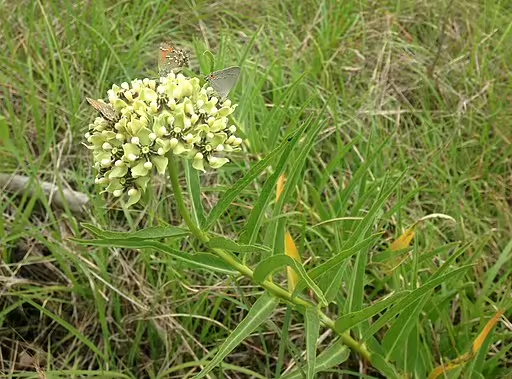
Facts about Spider Milkweed
- Native to Wyoming: No (Kartesz 2015)
- Native to Natrona County: No
- Natural Habitat: open areas that are dry and rocky, desert swales or desert shrub
- Height: 1 ft (0.3 m) to 3 ft (0.9 m)
- Flower Color: yellowish-green (Woodson 1954) with a dark purple hood
- Flowering Period: March to September
- USDA Hardiness Zone: 5-9
Gardening with Spider Milkweed
In your Natrona County, WY butterfly garden, this milkweed needs full sun and dry/rocky soils. This milkweed is native to the south in Colorado, but can handle the plant hardiness zone of Natrona County. During cold snaps this plant will need to be sheltered.
3. Pallid Milkweed (Asclepias cryptoceras), a Milkweed for Dry Sandy/Rocky Soils
Pallid milkweed is native just to the south of Natrona County and is a small plant that is also suitable for containers and small plants. Just be sure to have full sun and a dry/rocky soil. It is also important to try to replicate its natural environment as much as possible.

Facts about Pallid Milkweed
- Native to Wyoming: Yes, south-central and southwestern counties (Kartesz 2015)
- Native to Natrona County: No
- Natural Habitat: sandy washes and canyon bottoms (Jepson eflora) and talus slopes (Baker 1971)
- Height: 0.4 ft (0.1 m) to 1 ft (0.3 m)
- Flower Color: Yellowish-green (Woodson 1954) to cream-white (Heil, et al 2013)
- Flowering Period: April to June
- USDA Hardiness Zone: 4-7
Gardening with Pallid Milkweed
In your Natrona County, WY butterfly garden, this milkweed needs full sun and dry/rocky sandy soils. Due to its rarity, this plant is not likely in the horticultural trade.
4. Englemann’s Milkweed (Asclepias engelmanniana), a Milkweed for Well-drained Soils
Englemann’s milkweed is an excellent milkweed if you have a full sun location in well-drained soil. In Natrona County, this medium sized milkweed would do well in raised beds that has a mixture of sand and compost added. This plant can handle droughts once it is established. Potential partners for this milkweed in Natrona County include penstemon (Penstemon spp.), goldenrod (Solidago spp.), and yarrow (Achillea spp.). Generally this plant grows between 4,000 ft to 8,000 ft.

Facts about Engelmann’s Milkweed
- Native to Wyoming: Yes, rare in Goshen County (Kartesz 2015)
- Native to Natrona County: No
- Natural Habitat: desert swales, scrub, and pastures
- Height: 1 ft (0.3 m) to 5 ft (1.5 m)
- Flower Color: cream-green
- Flowering Period: May to September
- USDA Hardiness Zone: 4-9
Gardening with Engelmann’s Milkweed
In your Natrona County, WY butterfly garden, this milkweed needs full sun and dry sandy and/or limestone soils.
5. Hall’s Milkweed (Asclepias hallii), a Milkweed for Sandy Well-drained Soils
Hall’s milkweed is a small to medium sized plant that may be suitable for containers. Like the Engelmann’s milkweed it could be planted in raised beds, with planting occurring in the fall or started indoors about 6 to 8 weeks before the first frost. This milkweed is often found between 5,000 ft and 9,000 ft of elevation and some possible companion plants include yarrow (Achillea spp.), Gaillardia (Gaillardia spp.), and scarlet gilia (Ipomopsis aggregata).

Facts about Hall’s Milkweed
- Native to Wyoming: Yes, rare in Albany County (Kartesz 2015)
- Native to Natrona County: No
- Natural Habitat: prairies, roadsides, rocky slopes, steppes, and woodlands that between 6,000 ft. and 8,000 ft. of elevation
- Height: 1 ft (0.3 m) to 3 ft (0.9 m)
- Flower Color: white, whitish-green, rose, pink to purple
- Flowering Period: June to August
- USDA Hardiness Zone: 3-9
Gardening with Hall’s Milkweed
In your Natrona County, WY butterfly garden, this milkweed needs full sun, but can handle partial-shade. Soils should be sandy and well-drained.
6. Swamp Milkweed (Asclepias incarnata), a Milkweed for Moist Soils
If you have land that is wet or moist in Natrona County, WY, this milkweed may be for you. The natural color is generally pink, but there is also a white cultivar called ‘Ice Ballet.’ While this species can exist in the plant hardiness zone of the county, care must be taken to satisy the moisture requirements of the plant. You need to water it frequently and in Natrona County it may be a high maintenance plant, but can be a nice compliment to any butterfly garden if you put in the time.
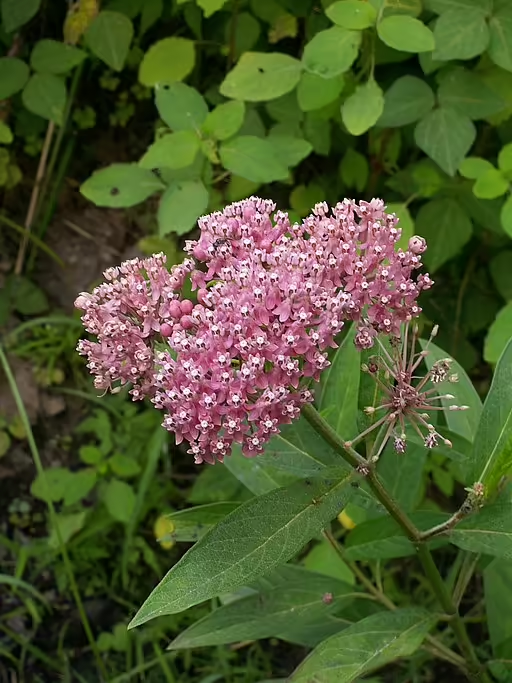
Facts about Swamp Milkweed
Asclepias incarnata subsp. incarnata in Wyoming
- Native to Wyoming: Yes, northwestern and northeastern counties (Kartesz 2015)
- Native to Natrona County: No
- Natural Habitat: shores of streams, lakes, ponds, and other wetlands
- Height: 3 ft (0.9 m) to 5 ft (1.5 m)
- Flower Color: pink or red
- Flowering Period: July to September
- USDA Hardiness Zone: 3-9
Gardening with Swamp Milkweed
In your Natrona County, WY butterfly garden, this milkweed needs full sun to partial shade and medium to moist soil.
7. Broad-leaf Milkweed (Asclepias latifolia), a Milkweed for Dry Sandy Soils
This milkweed may be a good candidate for a raised bed that has a full sun exposure. Soils should be well-drained and contain a high amount of sand. Companion plants include yarrow (Achillea spp.), gaillardia (Gaillardia spp.), scarlet gilia (Ipomopsis aggregata), and penstemon (Penstemon spp.). Complimentary shrubs include Wyoming sagebrush (Artemisia tridentata) and chokecherry (Prunus virginiana).
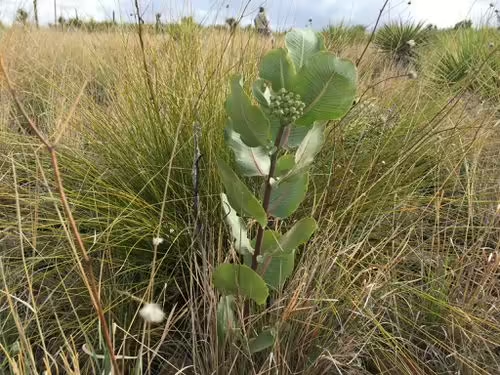
Facts about Broad-leaf Milkweed
- Native to Wyoming: No (Kartesz 2015)
- Native to Natrona County: No
- Natural Habitat: prairies, roadsides, and right-of-ways
- Height: 1 ft (0.3 m) to 3 ft (0.9 m)
- Flower Color: greenish to yellow
- Flowering Period: May to August
- USDA Hardiness Zone: 5-8
Gardening with Broad-leaf Milkweed
In your Natrona County, WY butterfly garden, this milkweed needs full sun to partial sun and dry sandy soil.
8. Oval-leaf Milkweed (Asclepias ovalifolia), a Milkweed for Well-drained Soils
Oval-leaf milkweed is a fairly small milkweed that thrives in well-drained soils. The small size makes it a candidate for container and small gardens. Pay attention to the cold, as it may have a hard time if it gets too cold. Companion plants are similar to the broad-leaf milkweed (Asclepias latifolia).
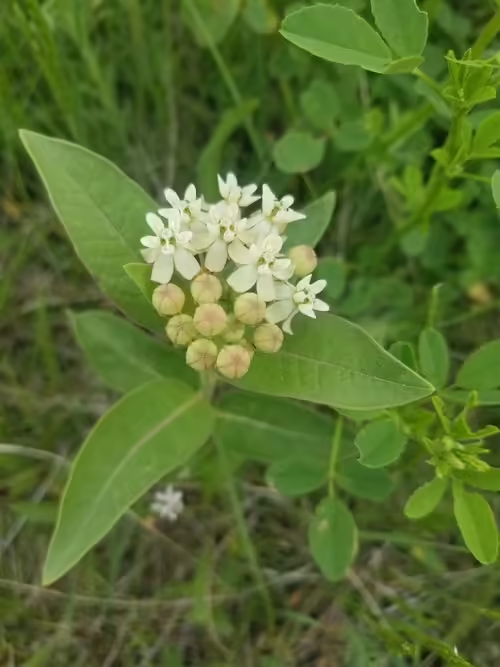
Facts about Oval-leaf Milkweed
- Native to Wyoming: Yes, northeastern counties (Kartesz 2015)
- Native to Natrona County: No
- Natural Habitat: tallgrass prairies on slopes (Caitlin and Kostiuk 2006), grasslands and savannas (Timoney and Robinson 1998), alluvial terraces (Vanderhorst and Cooper 1998), railroad edges (Woodson 1954), barrens and open woodlands
- Height: up to 2 ft (0.6 m)
- Flower Color: white, pinkish, or green with a purplish tinge
- Flowering Period: May to August
- USDA Hardiness Zone: 5-9
Gardening with Oval-leaf Milkweed
In your Natrona County, WY butterfly garden, this milkweed needs full sun to partial shade and well-drained soil that has higher pH.
9. Low Milkweed (Asclepias pumila), a Milkweed for Dry Sandy and/or Gravelly Soils
Low milkweed is one of the smallest milkweeds on the list and thrives in dry sandy soils that are well-drained. Seeds of this species should be planted in the fall or started about 6-8 weeks before the last frost. This plant is drought-tolerant once established. Possible companion plants include pasqueflower (Anemone patens), Wyoming phlox (Phlox paniculata), blanketflower (Gaillardia aristata), yarrow (Achilla millefolium), and goldenrod (Solidago spp.). Plants should be spaced far enough apart to ensure good air circulation.
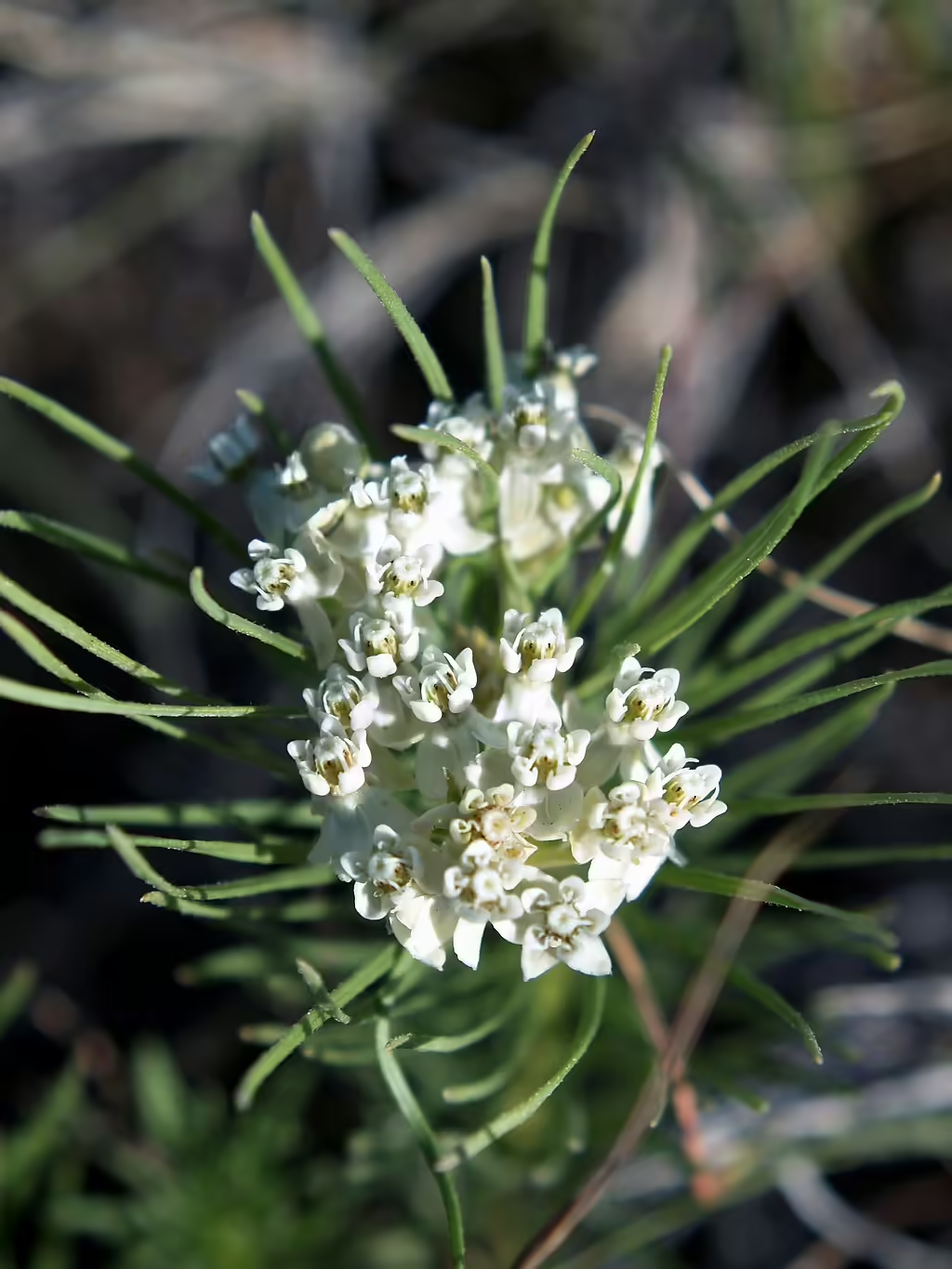
Facts about Low Milkweed
- Native to Wyoming: Yes, eastern counties (Kartesz 2015)
- Native to Natrona County: No
- Natural Habitat: dry prairies (Rydberg 1900) and plains at moderate elevation
- Height: 0.5 ft (0.2 m) to 1.5 ft (0.5 m)
- Flower Color: white with reddish accents to yellowish-green or greenish-white
- Flowering Period: July to September
- USDA Hardiness Zone: 5-9
Gardening with Low Milkweed
In your Natrona County, WY butterfly garden, this milkweed needs full sun and dry sandy and gravelly soils.
10. Showy Milkweed (Asclepias speciosa), a Milkweed for Medium to Well-drained Soils
Showy milkweed is a plant in butterfly gardens around the United States. It is a small to medium sized plant, making it suitable for containers, but whether planted or in a container, it needs good well-drained soil. Like a number of the other milkwerds this species can be planted by seed in the fall or started about 6-8 weeks before the last frost. Compnaion species are similar to those for the low milkweed (Asclepias pumila).

Facts about Showy Milkweed
- Native to Wyoming: Yes, throughout (Kartesz 2015)
- Native to Natrona County: Yes
- Natural Habitat: roadsides, fields and woodlands
- Height: 1 ft (0.3 m) to 3 ft (0.9 m)
- Flower Color: purple to pink
- Flowering Period: April to June
- USDA Hardiness Zone: 3-9
Gardening with Showy Milkweed
In your Natrona County, WY butterfly garden, this milkweed needs full sun and medium to well-drained soil.
11. Slim-leaf Milkweed (Asclepias stenophylla), a Milkweed Dry Sandy or Gravelly Soils
Slim-leaf milkweed likes places of full sun on well-drained sandy soils. Seeds can sown in the fall or after the last frost. Alternatively, plants can be started about 6-8 weeks before the last frost. Plants should have enough spacing to allow for air circulation. Potential companion plants include butterfly weed (Asclepias tuberosa), scarlet gilia (Ipomopsis aggregata), blue grama (Bouteloua gracilis), antelope bitterbrush (Purshia tridentata), and serviceberry (Amelanchier alnifolia).
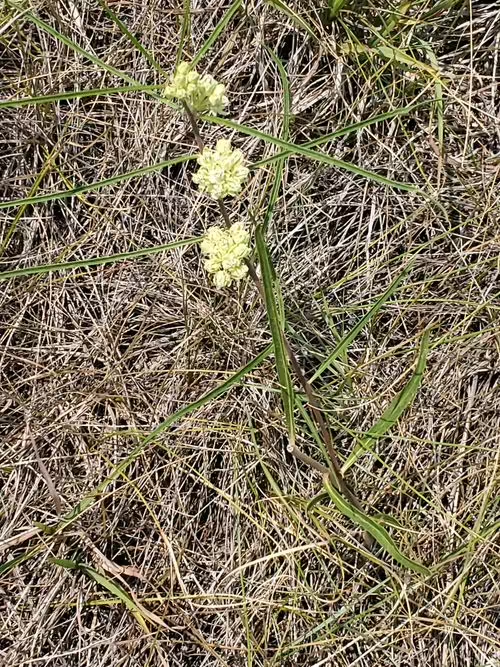
Facts about Slim-leaf Milkweed
- Native to Wyoming: Yes, northeastern counties (Kartesz 2015)
- Native to Natrona County: No
- Natural Habitat: prairies with sandy or gravelly soils
- Height: 0.8 ft (0.3 m) to 3 ft (0.9 m)
- Flower Color: greenish-white
- Flowering Period: June to August
- USDA Hardiness Zone: 3-9
Gardening with Slim-leaf Milkweed
In your Natrona County, WY butterfly garden, this milkweed needs full sun and dry sandy to gravelly soils.
12. Horsetail Milkweed (Asclepias subverticillata), a Milkweed for all Soils
Horsetail milkweed is a historic species to Wyoming, but it can still handle the plant hardiness zone here. It requires areas of full sun and generally well-drained sandy soil. Seeds can be sown in the fall, or plants can be started in the spring after the first frost. They can also be reproduced by rhizomes from established plants. Potential companion plants include Wyoming blazing star (Liatris punctata), penstemon (Penstemon palmeri), Indian ricegrass (Oryzopsis hymenoides), and gaillardia (Gaillardia aristata). This species can take awhile to establish, so patience is key.

Facts about Horsetail Milkweed
- Native to Wyoming: Yes, historic to the state in Carbon County (Kartesz 2015)
- Native to Natrona County: No
- Natural Habitat: plains and flats (Woodson 1954), prairies (Singhurst, et al 2015), canyon sides (Holiday 2000), roadsides (Kindscher 2020), waste places (Welsh and Erdman 1964), and wet areas near streams and ditches (Correll and Correll 1972)
- Height: up to 4 ft (1.2 m)
- Flower Color: white, sometimes with purple (Woodson 1954) or greenish-white (Vail 1898)
- Flowering Period: May to September
- USDA Hardiness Zone: 5-8
Gardening with Horsetail Milkweed
In your Natrona County, WY butterfly garden, this milkweed needs full sun and can handle a variety of soil moisture conditions. During cold snaps, you may want to shelter this plant since it is at the bottom end of its hardiness zone.
13. Butterfly Weed (Asclepias tuberosa), a Milkweed for all Conditions
Butterfly weed is one of three milkweeds in the United States that has an orange colored flower and in Wyoming can add a different color to your garden. While requiring full sun, it can handle most well-drained soil conditions. Plants that compliment this species include other milkweeds as appropriate to the area, scarlet gilia (Ipomopsis aggregata), and gaillardia (Gaillardia aristata). Be sure to select a variety of plants to have year-round blooming.

Facts about Butterfly Weed
- Native to Wyoming: No (Kartesz 2015)
- Native to Natrona County: No
- Natural Habitat: fields, roadsides and open woods
- Height: 1 ft (0.3 m) to 3 ft (0.9 m)
- Flower Color: orange
- Flowering Period: June to October
- USDA Hardiness Zone: 3-9
Gardening with Butterfly Weed
In your Natrona County, WY butterfly garden, this milkweed needs full sun and nearly any soil type. While this milkweed is not native to the area it can handle the plant hardiness zone and is native to adjacent states.
14. Whorled Milkweed (Asclepias verticillata), a Milkweed for Medium to Dry Soil
Whorled milkweed gets its name from its whorled leaves and makes for an interesting texture in butterfly gardens. Generally this plant favors places of full sun and soils that are medium to dry and well-drained. Make sure that plants are spaced so they get air circulation and its small size allows for a possible container plant. Potential companion plants include yarrow (Achillea millefolium), coneflower (Echinacea angustifolia), and serviceberry (Amelanchier alnifolia). This species may be affected by the dry winds present in the area so some protection may want to be provided.

Facts about Whorled Milkweed
- Native to Wyoming: Yes, rare in Crook County (Kartesz 2015)
- Native to Natrona County: No
- Natural Habitat: prairies, fields, meadows, pine sandhills, rock outcrops, and roadsides
- Height: 1 ft (0.3 m) to 3 ft (0.9 m)
- Flower Color: green to white, sometimes with a purplish tinge
- Flowering Period: April to September
- USDA Hardiness Zone: 3-9
Gardening with Whorled Milkweed
In your Natrona County, WY butterfly garden, this milkweed needs full sun and medium to dry soils.
15. Green Comet Milkweed (Asclepias viridiflora), a Milkweed for Medium to Dry Sandy Soil
Green comet milkweed likes full sun or partial shade in well-drained sandy or rocky soil. Since this a small to medium sized milkweed, it is a possible plant for container gardens. Potential companion plants include penstemon (Penstemon spp.), yarrow (Achillea millefolium), purple coneflower (Echinacea angustifolia), Wyoming bitterroot (Lewisia rediviva), and Indiangrass (Sorghastrum nutans).
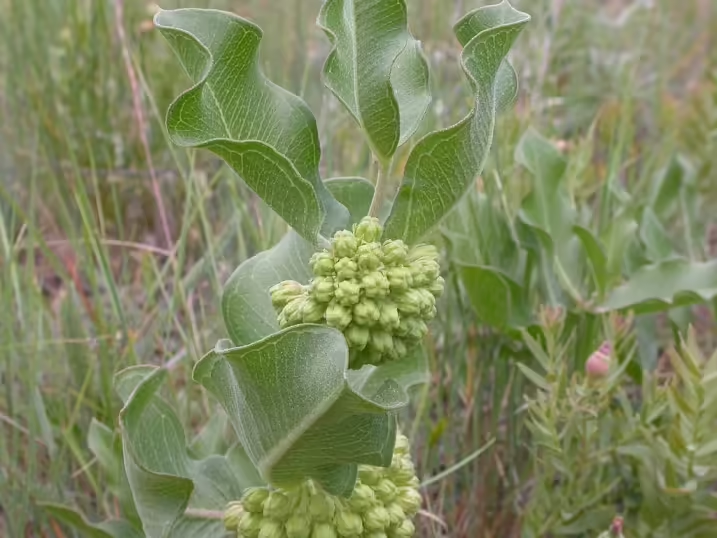
Facts about Green Comet Milkweed
- Native to Wyoming: Yes, rare in Crook County (Kartesz 2015)
- Native to Natrona County: Yes
- Natural Habitat: fields, dunes, prairies, shaded roadsides, forest borders, and railroads
- Height: 1 ft (0.3 m) to 3 ft (0.9 m)
- Flower Color: green becoming yellow-green to purple-green with age
- Flowering Period: July to August
- USDA Hardiness Zone: 3-9
Gardening with Green Comet Milkweed
In your Natrona County, WY butterfly garden, this milkweed needs full sun to partial shade and medium to dry sandy soil.
When selecting your Natrona Countty, WY milkweed, be sure to make sure that it grows in your zone and habitat.
Books where you can find out more about Monarchs and Butterfly Gardening in Natrona County, WY
- Daniels, Jaret C. 2022. Garden Bugs & Insects of the Northwest – Identify Pollinators, Pests, and Other Garden Visitors – Adventure Quick Guides. Adventure Publications. 36 pp.
- Daniels, Jaret C. 2020. Butterflies of the Northwest – Your Way to Easily Identify Butterflies – Adventure Quick Guides. Adventure Publications.
- Denver Botanic Gardens, Inc. 2024. Pollinators of the American West – A Field Guide to Over 300 Invertebrate Pollinators. Globe Pequot. 320 pp. (will be published in December 2024)
- Freeman, John F. 2023. High Plains Horticulture – A History. University Press of Colorado. 296 pp.
- Gorges, Barb. 2022. Cheyenne Garden Gossip: Locals Share Secrets for High Plains Gardening Success. Yucca Road Press. 326 pp.
- Kirkpatrick, Zoe Merriman. 2008. Wildflowers of the Western Plains: A Field Guide. Bison Books.
- Miller, George Oxford. 2024. Native Plant Gardening for Birds, Bees & Butterflies: Rocky Mountains – Nature Friendly Gardens. Adventure Publications. 280 pp. (will be published in July 2024)
- Parkinson. 2015. Landscaping With Native Plants of the Intermountain Region. Createspace. 54 pp.
Affiliate Disclosure: When you click on links to various merchants on this site and make a purchase, this site can earn a commission at no extra cost to you. Affiliate programs include, but are not limited to, the eBay Partner Network and Blackwell’s Books.
References for Natrona County, WY Milkweeds
- Caitling, Paul M. and Brenda Kostiuk. 2006. Tallgrass Prairie in the Whitewood Area of Saskatchewan. Blue Jay 64: 72-83.
- Correll, Donovan Stewart and Helen B. Correll. 1972. Aquatic and Wetland Plants of southwestern United States. (Washington, DC: EPA).
- Holiday, Susan. 2000. A Floristic Study of Tsegi Canyon, Arizona. Madrono 47: 29-42.
- Kindscher, Kelly. 2020. The Vascular Plants of Lake Roberts, Gila National Forest, Grant County, New Mexico. The New Mexico Botanist 68: 1-22.
- Rydberg, Per Axel. 1900. Catalogue of the Flora of Montana and Yellowstone National Park. Memoirs of the New York Botanical Garden. (New York: New York Botanical Garden).
- Singhurst, Jason, Ben Hutchins, and Wlater Holmes. 2015. Idenfication of Milkweeds of Texas. Texas Parks and Wildlife Department.
- Timoney, Kevin and Anne Robinson. 1998. A floristic and landscape survey of the Ft. Assiniboine Sandhills Wildland Park. Sherwood Park Alta, Treeline Ecological Research.
- Urguhart, Fredrick Albert, Norah Roden Urguhart, and Francis Munger. 1968. Population of Danaus plexippus in Southern California. Journal of Research on the Lepidoptera 7(4): 169-181.
- Vail, Anna Murray. 1898. Studies in the Asclepiadaceae – III. Descriptions of New Species. Bulletin of the Torrey Botanical Club 25(4): 171-182.
- Vanderhorst, James P. and Stephen V. Cooper. 1998. Botanical and vegetation survey of Carter County, Montana, Bureau of Land Management-administered lands. Helena, MT: Montana Natural Heritage Program.
- Woodson, Robert E. 1954. The North American Species of Asclepias L. Annals of the Missouri Botanical Garden 41: 1-211.